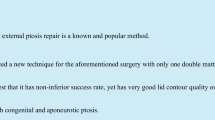Abstract
When faced with a patient with bilateral true ptosis, the question arises as to whether to operate on both lids simultaneously at one sitting or, sequentially, separated by weeks or months. Sound arguments can be made to support each approach, especially if contemplating bilateral external levator procedures. Less of an argument for sequential surgery might be made if considering bilateral conjunctival-mullerectomy (Putterman procedure), since active patient participation for lid height adjustment is not as critical in this operation as opposed to levator surgery.
Access provided by Autonomous University of Puebla. Download chapter PDF
Similar content being viewed by others
Keywords
When faced with a patient with bilateral true ‑ptosis, the question arises as to whether to operate on both lids simultaneously at one sitting or, sequentially, separated by weeks or months. Sound arguments can be made to support each approach, especially if contemplating bilateral external levator procedures. Less of an argument for sequential surgery might be made if considering bilateral conjunctival-mullerectomy (Putterman procedure), since active patient participation for lid height adjustment is not as critical in this operation as opposed to levator surgery.
For the sake of this discussion, financial implications of surgical cost and reimbursement of single- or multiple-episode surgery are not considered.
Bilateral simultaneous surgery is no doubt more convenient for the patient—one anesthetic episode, one trip to the surgery suite, and one operative and convalescent period away from work. It may also be more efficient and convenient for the surgeon. Theoretically, the surgeon can set one lid at the desired height and immediately use it as a guide for the fellow lid (i.e., complete one lid and then start the next). Alternatively, some surgeons may alternate from one lid to the other, doing similar steps on both lids simultaneously and adjusting both lids simultaneously—this is a relatively more advanced technique and requires expert knowledge of anatomy, precise dissection, and economy of movement. Speed is critical in this approach, as in less-than-expert hands, the local anesthetic may wear off prior to completion, requiring supplemental injections, often into the deeper tissue planes: these injections may then pharmacologically paralyze the levator, making subsequent height adjustment all the more difficult.
Regardless of technique, balancing the advantages of simultaneous surgery is the real-life possibilities of asymmetric intraoperative lid swelling and edema of one lid or dyspraxia of the lid (usually as a result of local anesthesia diffusing into levator), which complicates the adjustment of the fellow eyelid. This might also occur with longer operative times, as in the case of the occasional or infrequent ptosis surgeon—the longer the operation, the more likely the intraoperative swelling will become significant. Some surgeons would then advocate ignoring the height of the first lid and independently placing the second lid at the desired height (i.e., place each lid at the desired anatomic height as separate efforts). While this approach is generally reliable, it does not adequately address the additional possible intraoperative contribution of Hering’s law on lid height. In actuality, of course, the possibility of Hering’s contribution occurs regardless of the state of edema and swelling. In either case, the surgeon may then be faced with unexpected postoperative asymmetry and the prospect of having to reoperate one lid or the other at a later date. Most oculoplastic surgeons will admit to some percentage of postoperative asymmetries that require revision.
Of course, any operation through previously traumatized tissues complicates the subsequent surgery for a variety of reasons: landmarks are distorted; bleeding may be more profuse; scarring and cicatrix are unpredictable; and cicatrix is difficult to anesthetize, often requiring larger anesthetic volumes, which may then further distort anatomy or color the surgical endpoint. Most surgeons, if given the choice of operating on virgin anatomy versus reoperating, would choose the former. Consequently, if any surgeon has an x% chance of postoperative asymmetry necessitating revision (in his or her own hands), the surgeon must frankly ask himself or herself whether that percentage of reoperation is outweighed by the convenience of simultaneous surgery. Intuitively, the more experienced the surgeon, the smaller x should be (and conversely, the higher (1.00−x)—the chance for success with a single surgery—should be). In less experienced hands, however, the prospect of performing a second and ostensibly more difficult operation may mitigate to sequential surgery, wherein one lid is operated and allowed to heal and is then used as a gauge for matching the virgin fellow lid at a second, separate surgery.
I discuss these scenarios preoperatively with patients and solicit their thoughts and desires. I have found most patients understanding of the difficulties and subtleties of ptosis surgery and willing and appreciative participants in the decision of how to proceed in their own medical care. Many factors weigh into their individual decisions. Some are understandably anxious about surgery and want it over with as quickly and painlessly as possible, often saying “Doc, you’ve got me once. . . . I’ll take my chances and live with a little asymmetry.” Others, dreading the possibility of unsightly asymmetry and the prospect of a second, more difficult surgery, will opt for sequential surgery. In any case, I now involve the patient in the discussion and decision and proceed as the patient desires.
Author information
Authors and Affiliations
Corresponding author
Editor information
Editors and Affiliations
Additional information
Disclaimer The views expressed in this chapter are those of the author and do not reflect the official policy of the Department of Defense, the Department of Veterans Affairs, the Department of the Navy, or the US Government.
Rights and permissions
Copyright information
© 2015 Springer Science+Business Media New York
About this chapter
Cite this chapter
Mazzoli, R.A. (2015). Considerations in Simultaneous Versus Sequential Bilateral Levator Repair. In: Hartstein, MD, FACS, M., Massry, MD, FACS, G., Holds, MD, FACS, J. (eds) Pearls and Pitfalls in Cosmetic Oculoplastic Surgery. Springer, New York, NY. https://doi.org/10.1007/978-1-4939-1544-6_181
Download citation
DOI: https://doi.org/10.1007/978-1-4939-1544-6_181
Published:
Publisher Name: Springer, New York, NY
Print ISBN: 978-1-4939-1543-9
Online ISBN: 978-1-4939-1544-6
eBook Packages: MedicineMedicine (R0)




